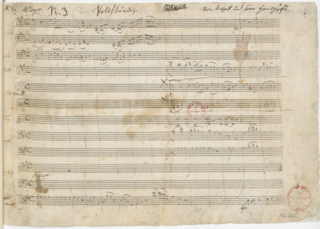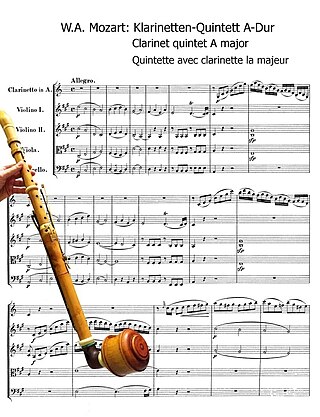Adagio and Allegro in F minor for a mechanical organ, K. 594, is a composition by Wolfgang Amadeus Mozart, completed in late 1790.
Contents

Adagio and Allegro in F minor for a mechanical organ, K. 594, is a composition by Wolfgang Amadeus Mozart, completed in late 1790.

The piece was commissioned by Count Joseph Deym von Stritetz for use as a funeral mass to be played on a mechanical organ clock in the mausoleum for the recently deceased Generalfeldmarschall (Fieldmarshall) Ernst Gideon von Laudon, part of the Müllersche Kunstgalerie, the wax art gallery and organ museum of "Joseph Müller" (which was the Count Deym's assumed name). [1] [2] This displayed a casket covered with glass, through which one could view a wax figure of the Field Marshall. When the clock struck the hour, a lament was heard: a new one each week, one of which was Mozart's Adagio and Allegro. [3] [4]
Although Mozart intended the piece to be played on a mechanical clockwork organ, [5] he wished later that it could be played on a conventional organ. In a letter to his wife Constanze dated 3 October 1790, he wrote, "If it were on a large clock-work with a sound like an organ, I'd be glad to do it; but as it is a thing made up of tiny pipes only, which sound too shrill and childish for me". [4] As time passed, Mozart seemed to be content with the decision, saying later that the work and its installation in the gallery in "fruitlessness and purity and compatibility to the works of art eclipses anything that anyone has ever succeeded in producing".[ citation needed ] The piece takes about twelve minutes to perform.

The piece has three movements.
In 1791 Mozart wrote another piece in F minor for mechanical organ, "Ein Orgel Stück für eine Uhr" (an organ piece for a clock), K.608. This composition is believed to have also been commissioned by Count Deym. [3] [5]

The String Quartet No. 6 in B-flat major, Op. 18, No. 6, was written between 1798 and 1800 by Ludwig van Beethoven and published in 1801, and dedicated to Joseph Franz von Lobkowitz.

The Piano Concerto No. 20 in D minor, K. 466, was composed by Wolfgang Amadeus Mozart in 1785. The first performance took place at the Mehlgrube Casino in Vienna on 11 February 1785, with the composer as the soloist.

The Violin Concerto No. 3 in G major, K. 216, was composed by Wolfgang Amadeus Mozart in Salzburg in 1775 when he was 19 years old. In a letter to his father, Mozart called it the "Straßburg-Concert". Researchers believe this epithet comes from the motive in the third movement's Allegretto in the central section, a local dance that already had appeared as a musette-imitating tune in a symphony by Carl Ditters von Dittersdorf.

The Piano Concerto No. 23 in A major K. 488 is a concerto for piano and orchestra written by Wolfgang Amadeus Mozart. It was finished, according to Mozart's own catalogue, on March 2, 1786, two months prior to the premiere of his opera, Le nozze di Figaro, and some three weeks prior to the completion of his next piano concerto. It was one of three subscription concerts given that spring and was probably played by Mozart himself at one of these.

Wolfgang Amadeus Mozart's Clarinet Quintet, K. 581, was written in 1789 for the clarinetist Anton Stadler. A clarinet quintet is a work for one clarinet and a string quartet. Although originally written for basset clarinet, in contemporary performances it is usually played on a clarinet in A. It was Mozart's only completed clarinet quintet, and is one of the earliest and best-known works written especially for the instrument. It remains to this day one of the most admired of the composer's works. The quintet is sometimes referred to as the Stadler Quintet; Mozart so described it in a letter of April 1790. Mozart also wrote a trio for clarinet, viola and piano for Stadler, the so-called Kegelstatt Trio, in 1786.

The Violin Concerto No. 5 in A major, K. 219, often referred to by the nickname "Turkish", was written by Wolfgang Amadeus Mozart in 1775, premiering during the Christmas season that year in Salzburg. It follows the typical fast-slow-fast musical structure.

The String Quartet No. 19 in C Major, K. 465 by Wolfgang Amadeus Mozart, nicknamed "Dissonance" on account of its unusual slow introduction, is perhaps the most famous of his quartets.
The String Quintet No. 4 in G minor, K. 516, written by Wolfgang Amadeus Mozart, is like all of Mozart's string quintets a "viola quintet" in that it is scored for string quartet and an extra viola . The mood of the piece is dark and melancholic, typical of Mozart's G minor works.

The Flute Concerto No. 1 in G major, K. 313, was written in 1778 by Wolfgang Amadeus Mozart.
Johannes Brahms's Clarinet Quintet in B minor, Op. 115, was written in 1891 for the clarinettist Richard Mühlfeld. It is scored for a clarinet in A with a string quartet. It has a duration of approximately thirty-five minutes.

Wolfgang Amadeus Mozart's Piano Sonata No. 2 in F major, K 280 / 189e, (1774) is a piano sonata in three movements. The work was written down along with other piano sonatas during the visit Mozart paid to Munich for the production of La finta giardiniera from late 1774 to the beginning of the following March. A typical performance of the sonata takes about 14 minutes.

Wolfgang Amadeus Mozart's Piano Sonata No. 6 in D major, K. 284 / 205b, (1775) is a sonata in three movements:
Felix Mendelssohn's Cello Sonata No. 2 in D major, Op. 58, was composed in late 1842 — first half of 1843. The main theme of the first movement is a reworking of an unrealised Piano Sonata in G major. The Cello Sonata, which was dedicated to the Russian/Polish cellist Count Mateusz Wielhorski, has four movements:
Carl Maria von Weber wrote his Clarinet Concerto No. 1 in F minor, Op. 73 for the clarinettist Heinrich Bärmann in 1811. The piece is highly regarded in the instrument's repertoire. It is written for clarinet in B♭. The work consists of three movements in the form of fast, slow, fast. It was premiered in Munich on 13 June 1811, with Maximilian I Joseph of Bavaria in attendance.

Vesperae solennes de Dominica, K. 321, is a sacred choral composition, written by Wolfgang Amadeus Mozart in 1779. It is scored for SATB choir and soloists, violin I and II, 2 trumpets, 3 trombones colla parte, 2 timpani, and basso continuo.

The Piano Trio No. 1 in B major, Op. 8, by Johannes Brahms was completed in January 1854, when the composer was only twenty years old, published in November 1854 and premiered on 13 October 1855 in Danzig. It has often been mistakenly claimed that the first performance had taken place in the United States. Brahms produced a revised version of the work in summer 1889 that shows significant alterations so that it may even be regarded as a distinct (fourth) piano trio. This "New Edition", as he called it, was premiered on 10 January 1890 in Budapest and published in February 1891.
The six string quartets, K. 168–173, were composed by Wolfgang Amadeus Mozart in late 1773 in Vienna. These are popularly known as the Viennese Quartets. Mozart may have hoped to have them published at the time, but they were published only posthumously by Johann André in 1801 as Mozart's Op. 94.
Fantasia No. 4 in C minor, K. 475 is a composition for solo piano composed by Wolfgang Amadeus Mozart in Vienna on 20 May 1785. It was published as Opus 11, in December 1785, together with the Sonata in C minor, K. 457, the only one of Mozart's piano sonatas to be published together with a work of a different genre.
The Divertimento No. 17 in D major, K. 334/320b was composed by Wolfgang Amadeus Mozart between 1779 and 1780 and was possibly composed for commemorating the graduation of a close friend of Mozart's, Georg Sigismund Robinig, from his law studies at the University of Salzburg in 1780. Lasting about 42 minutes, it is the longest of the divertimenti by Mozart.

The composition of Mozart's unfinished Requiem, K. 626, his last work, is surrounded by the following events.